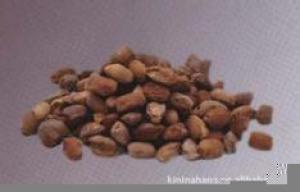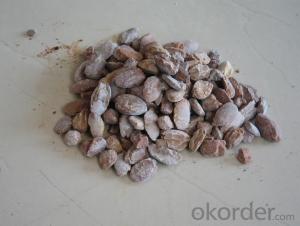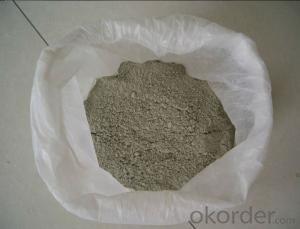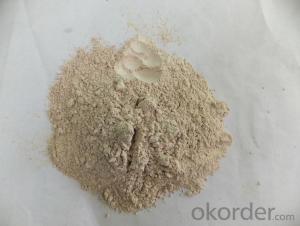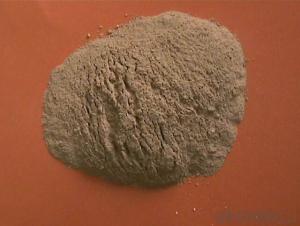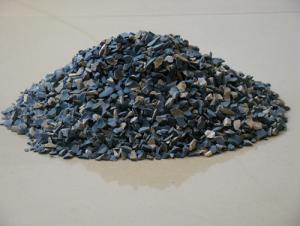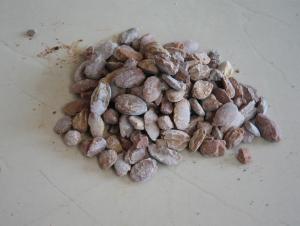Raw Materials for Refractory:Dead Burnt Magnesite MgO 94.5%
- Loading Port:
- Dalian
- Payment Terms:
- TT OR LC
- Min Order Qty:
- -
- Supply Capability:
- 2000 m.t./month
OKorder Service Pledge
OKorder Financial Service
You Might Also Like
| Item | MgO | SiO2 | CaO | LOI | B.D.(g/cm3) |
| DBM-97 | 97 | 0.7 | 1.4 | 0.2 | 3.2 |
| DBM-96 | 96 | 1.5 | 1.5 | 0.2 | 3.2 |
| DBM-95 | 95 | 2.2 | 1.6 | 0.3 | 3.2 |
| DBM-94 | 94 | 3 | 1.6 | 0.3 | 3.2 |
| DBM-93 | 93 | 3.5 | 1.6 | 0.3 | 3.2 |
| DBM-92 | 92 | 4 | 1.6 | 0.3 | 3.18 |
| DBM-92 | 92 | 4 | 1.6 | 0.3 | 3.18 |
| DBM-91 | 91 | 4.5 | 1.6 | 0.3 | 3.18 |
| DBM-90 | 90 | 4.8 | 2 | 0.3 | 3.18 |
| DBM-87 | 87 | 7 | 2.2 | 0.3 | 3.2 |
Dead burned magnesite- DBM-is produced using selected natural magnesite that is purified and is calcined in a shaft kiln.The final product is used for electric furnacefloors and furnace liner tamping.
Main products level :
0-1mm;1-3mm;3-5mm;0-10mm;0-30mm
50 to 325mesh (90% through)
Product feature:
high temperature performance and high-density, strong anti-permeability ability and easy to rapid sintering, very thin sintered layer,good thermal shock stability, strong slag-resistance, long service life and so on.
Product function:
Apply to the construction of bottom and wall of all kinds steel making electric arc furnace and ferroalloy smelting furnace for hot charging of hot metal and second hand steel
Product usage:
Mainly used in producing common magnesite brick, magnesite aluminum brick, magnesite chrome brick, gunning mix, hot patching mix for converter and EAF ect .
Product Advantage:
Our factory produce the products of the Dead-burned magnesite are selected natural magnesite, it is produced by mine-selecting, purifying, calcimine in shaft kiln. It is an ideal material for unshaped refractory material, the final products are used in open hearth furnace, electric furnace bottom and furnace's lining tamping.
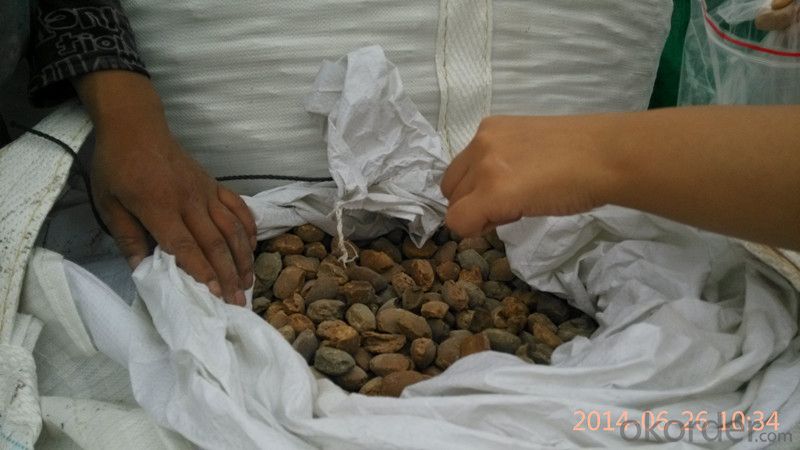
- Q: what grades are fire resistance of fireproofing glass divided into?
- Fireproofing glass is a kind of special glass which can keep its integrity and thermal insulation performance in regular insulating refractory trials. and it can be divided into three classes according to its fire resistance: Class A, it's a kind of fireproofing glass that can satisfy the requirements of refractory integrity, refractory and thermal insulation at the same time. This kind of glass has the properiyies of transmittance, fireproofing ( smoke insulation, fireproofing, and keeping out thermal radiation), sound insulation, shock resistance, and it's suitable for steel and wooden fire door of building decoration, windows, varnishing, partition walldaylighting?roof,ceiling?screen,perspective floor and other construction components demading for transparency and fireproofing. Class B, it's a kind of fireproofing glass that can satisfy the requirements of refractory integrity, refractory and thermal insulation at the same time. Such kind of fireproofing glasses mostly are composite fireproofing glasses and has characteristics of transmittance,fireproofing and smoke insulation. Class C, it's a kind of fireproofing glass that only satisfies the requirements of refractory integrity. This kind of glass has characteristics of transmittance, fireproofing, smoke insulation and high strength,etc. It's suitable for fireproofing glass partition wall, fire Windows, outside curtain wall and other places without insulation requirements.
- Q: How long is the fire-fighting time of A class fire resisting window?
- Fire resisting window' duration of fire resistance: A class window, fire insulation ≥1.50h and fire resistance integrity ≥1.50h. Fire resisting window can be divided into three kinds: 一. window frame and sash framework adopt fire resisting window with steel manufacture ; 二. window frame and sash framework adopt fire resisting window with wooden manufacture; 三. window frame adopt steel and sash adopt wooden material or window frame adopt wooden material and sash framework adopt fire resisting window with steel material.
- Q: which kind of material should be used in fireproofing cabinet?
- Here are a few good materials: 1. The mineral wool board, glass wool board: it mainly tales mineral wool, glass wool as insulation materials. It's non-combustible, light weight and has good high temperature resistance, but there are shortcomings ① short?fiber will harm the human respiratory system, ② poor sheet strength, ③ poor barrier property of sheet for smoke of fire disaster, ④ poor decorative properity, ⑤large installment and construction work. Thus, most of the boards were sheets that take inorganic anchoring material as base material, glass wool as reinforcing material. 2. cement board: Cement board has high strength and wide sources. It is often used in fireproof suspended?ceiling and partition in the past, but it has poor fire resistance and is easy to burst and lose protective function , which will limit it's applications. Cement concrete component has good thermal insulation and sound insulation properties, and it can be used as partition and roof board. Fiber reinforced cement board and other improved varieties appear in the construction?materials market, and they are high strength and have good fire resistance, but their disadvantages are poor toughness, large alkalinity and poor decoration effect. 3. perlite board, cenosphere board, vermiculite board: It's a kind of hollow plate that takes low alkalinity cement as base material, perlite, glass beads, vermiculite as the aerated filling material, and is made by adding some auxiliary. It has characteristics of light weight, high strength, good toughness, fireproofing and thermal insulation, easy for construction,etc. and it can be widely used in high-rise building frame compartment, household, bathroom, kitchen, communication pipe and other non-load bearing areas.
- Q: Who knows how to divide the building fire grade and fire resistance grade?
- I hope to help you building fireproof rank division is one of the most basic measure in building fire safety technical measures, Building's fireproof rank is divided into class one, two, three, four according to China's architectural design specification. Fire-resistant capability of the highest level is the strongest; Fire resistance of four level of the weakest. The fire resistance level of a building depends on the combustion performance and fire resistance of the building components that comprise the building. The so-called building component refers to a series of basic components, such as wall, foundation, beam, column, floor, stair, ceiling and so on.
- Q: How is the performance of refractory materials?
- It is a little difficult to answer. There are some requirement for refractory materials, such as fire resistance, softness, creep, thermal shock, abrasive resistance. Besides, requirements for construction performance include: Liquidity, plasticity and other linear change rate, volume density, strength (including high temperature) and all other important indicators must be tested the same conditions with the use of test conditions and test items like body density, strength, line changes in the basic project
- Q: Refractories for iron-making blast furnace?
- This question is too professional - as far as I know, there are blast furnace noumenon bricklaying - trough slag runner fire-resistant model ~ main channel carbon rod ~ ramming mixes ~ ~ I do not know the specific details.
- Q: What are the materials of class A fire resistant window?
- The filling materials of steel, wood frame should be non-combustible materials. Fireproof glass can use qualified products that do not affect the fire window fire resistance performance, whose light transmittance should be no less than 75% that of the commom sheet glass with the same layers. Sealing materials between the frame and fireproof glass should be nonflammable materials. Hardware fittings should be fixed supporting products that pass the test.
- Q: Who knows how many poured refactory material are there?
- Pouring refractory material can be classified into the followings according to the body density: Heavy (> 2.0g\cm3), medium heavy (1.0-2.0g\cm3), light (0.4-1.0g\cm3); by binding agent: Combination of hydration, chemical binding, condensation, hydration and condensation: Clay, high alumina, silica, magnesia, alumina magnesia, magnesium and chromium, magnesium zirconium, silicon carbide etc.. Clay brick, high alumina brick, bead brick, silica brick, light mullite, alumina hollow spherical brick, oxidation zirconium hollow spherical brick, corundum brick, magnesia brick, magnesia brick, magnesia alumina spinel brick, magnesia chrome brick and so on
- Q: What's the commonly used refractory material for ladle?
- 1. According to the refractoriness, it can be classified as follows: common refractory: 1580℃ ~ 1770℃; high grade refractory: 1770℃ ~ 2000℃; superrefractory: 2000 ℃; 2. According to the shape and demension of the product, it can be classified as follows: standard form : 230mm×113mm ×65mm of no more than four measuring scale, (demension ratio) Max: Min
Send your message to us
Raw Materials for Refractory:Dead Burnt Magnesite MgO 94.5%
- Loading Port:
- Dalian
- Payment Terms:
- TT OR LC
- Min Order Qty:
- -
- Supply Capability:
- 2000 m.t./month
OKorder Service Pledge
OKorder Financial Service
Similar products
Hot products
Hot Searches
Related keywords
